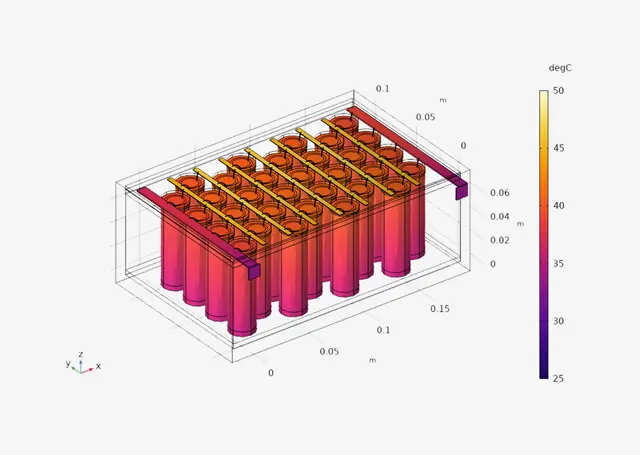About:Lumped Thermal
0D Lumped Temperature Model - Ensure safe, efficient operation with thermal performance modeling

Overview
About:Lumped is a simple thermal model which defines a lumped heat capacity for the whole battery. This model predicts the temperature evolution of a battery depending on internal heat generation rate, cooling efficiency, and external temperature.
Key features
- Compatible with any core battery model
Key applications
- Cell comparison and selection
- Determination of empirical cooling system requirements
Technical Description
About:Lumped solves a 0D heat equation for the average cell temperature, considering a lumped (total) heat capacity for the cell, internal heat generation, and cooling. Internal heat generation is equal to the power dissipation of the cell as irreversible losses (product of overvoltage with current). Cooling is expressed using a user-defined lumped heat transfer coefficient describing cooling from the cell exterior, according to Newton’s law of cooling.
Local thermal heterogeneity of the cell is ignored. Radiative cooling is not included.
Effectively isothermal behaviour can be achieved by setting \(C_\mathrm{p,cell}\) to an infinite value.
Mathematical Specification
Equations
Boundary Conditions
User Inputs: Operating Conditions
| Quantity | Unit | Description |
|---|---|---|
| \(T_\mathrm{ext}\) | K | Temperature, cell environment |
| \(T_0\) | K | Temperature, initial conditions |
| \(h_\mathrm{cell}\) | W/K | Heat transfer coefficient, cell exterior (total) |
Note that the external heat transfer coefficient \(h_\mathrm{cell}\) is highly environment-specific and for this reason must be set by the user.
Internal Quantities
Supplied Parameterisation
| Quantity | Value | Description |
|---|---|---|
| \(C_\mathrm{p,cell}\) | J/K | Heat capacity, cell (total) |
Internal Variables
All internal and inherited variables are expressed as functions of elapsed time (\(t\)).
| Quantity | Unit | Description |
|---|---|---|
| \(Q_\mathrm{ext}\) | W | Heat source from cell exterior |
| \(T\) | K | Temperature, cell (average) |
| \(t\) | s | Elapsed time |
Variables Inherited From Core Battery Model
| Quantity | Unit | Description |
|---|---|---|
| \(Q_\mathrm{cell}\) | W | Heat source, cell |
Implementation Details
CSV
The CSV implementation consists of raw parameterisation data. These data are intended for use with a user-defined implementation of the equations in the Mathematical Specification.
Parameterisation is given in cellprops.csv. Columns are named in a header row, and there is one data row containing the values for each property.
An additional helper parameter \(A_\mathrm{surf}\) is provided to facilitate conversion between the cell-level heat transfer coefficient defined in the Mathematical Specification and the commonly used areal heat transfer coefficient (\(h_\mathrm{surf}\), W/K/m\(^2\)):
| Quantity | Unit | Type | Column name |
|---|---|---|---|
| \(A_\mathrm{surf}\) | m\(^{2}\) | Scalar | Asurf_m2 |
| \(C_\mathrm{p,cell}\) | J/K | Scalar | Cp_cell_J_K-1 |
Simulink
The Simulink implementation requires a license for MATLAB R2021b or later, with Simulink and Simscape.
The implementation comprises Simulink blocks provided in ECM_Library.slx, which can be embedded in an application. Further documentation is provided internal to each block. See exampleModel.slx for an illustration of the coupling of a provided Simulink block to a user-defined model, including specification of operating conditions.
BPX JSON
The BPX JSON implementation consists of raw parameterisation data in a .json file compatible with the BPX v0.3 standard. These data are intended for use with a user-defined implementation of the equations in the Mathematical Specification.
The supplied parameterisation is provided as a derived quantity:
Paths are given relative to the JSON element Parameterisation/Cell, which is denoted . in relative paths below.
| Quantity | Unit | Definition | JSON Path |
|---|---|---|---|
| \(C_\mathrm{p,sp}\) | J/K/kg | Specific heat capacity, cell (total) | ./Specific heat capacity [J.K-1.kg-1] |
| \(\rho_\mathrm{cell}\) | kg/m\(^3\) | Density, cell (average) | ./Density [kg.m-3] |
| \(v_\mathrm{cell}\) | m\(^3\) | Volume, cell (total) | ./Volume [m3] |
PyBaMM
The PyBaMM implementation requires a Python environment supporting the dependencies listed in the provided requirements.txt.
All parameterisation data are provided in a BPX JSON format as described above, and are loaded into the PyBaMM ParameterValues object using the PyBaMM built-in method ParameterValues.create_from_bpx().
Version History
| Version | Release Date | Comments |
|---|---|---|
| 1.0 | 14 Mar 2023 | First release |
| 2.0 | 23 April 2025 | - Rename \(Q_\text{cool}\) to \(Q_\text{ext}\) |
